Protecting high performance race operations

Authored by Ken Mueller, AXA XL and Mel Eaves, Gulfway Insurers
Racers are revving up their engines. The National Hot Rod Association (NHRA) season kicks off in March with the Gatornationals to be held in Gainesville, Florida. An additional 20 races at motorsports parks across the country lead up to the NHRA Finals scheduled for early November in Pomona California.
The National Hot Rod Association is the largest auto racing organization in the world, representing some 180,000 drag racers in the US who race in 40 different classes, including four professional classes. One class — Top Fuel dragsters — are among the fastest-accelerating machines in the world. At 11,000-horsepower, they can cover a dragstrip in less than 3.7 seconds at more than 330 mph.
In addition to racing on US tracks, many drag racers will at some point find their way to tracks throughout Europe, Asia, the Middle East, and the Caribbean. Drag racing is one of the few sports with rules that are globally consistent. Growing interest in drag racing across the globe has made it a $1.26-billion market sector, according to the most recent survey from the Specialty Equipment Market Association’s (SEMA) Hot Rod Industry Alliance (HRIA).
Like most sports, the motorsports industry wrestled with challenges during the COVID-19 pandemic. Some impacts, including rising costs and shortages from supply chain disruptions are still being felt. And of course, there is the rising cost of fuel. According to Autoweek, NHRA teams pay $1,800 for a 40-gallon drum of nitromethane. Nitromethane fuel has increased oxygen which allows it to burn faster and with less atmospheric oxygen than conventional fuel. The increased oxygen gives it more power for fast acceleration. But right now, nitromethane costs $45 a gallon. One run consumes 14 gallons of fuel.
High value investment
One race car can start at $50,000 and top $300,000. Given the cost of everything including rising cost of replacement parts and repairs, damage to a car can be exceptionally costly to repair and replace parts.
When racetracks went idle during the pandemic, some racing cars owners cancelled their insurance policies, thinking the risks to their vehicles are significantly decreased when not being transported. There are, however, still some serious loss exposures for idle vehicles or in storage. Weather is one. Extreme weather can result in wind or flood damage to cars whether they are idle for long periods of time or in-transit to the next race. During Hurricane Ian, one car owner saw two vehicles – a 1970 Plymouth Superbird and 1969 Dodge Charger Daytona – swept off a post platform, six-feet high in his garage and swept away in the storm surge.
Other big exposures are fire and vandalism. In one recent incident, a 20-foot-long trailer and the race car inside were destroyed by fire. The driver pulled off a freeway when he saw smoke. He was able to disconnect his vehicle from the trailer before trying to put out the fire with a fire extinguisher before the fire department arrives. The fire’s cause was believed to be electrical, the result of a battery stored in the trailer becoming loose and falling against racing-fuel containers.
One race car can start at $50,000 and top $300,000. Given the cost of everything, including the rising cost of replacement parts and repairs, damage to a car can be exceptionally costly to repair and replace parts.
Proper protection
Given all the costs associated with owning and maintaining a hot rod, having the right motorsport insurance, particularly policies that cover cars when they are not racing, should be a top consideration.
Motorsport insurance policies are designed to cover damage while the car is in transit, in the shop, stored and at the racetrack while not in competition. Drag racers do not drive their cars to each racetrack. Rather they rely on tractor trailers to move their cars from here to there, and therefore, they rely on inland marine insurance coverage – a coverage designed to protect moveable property.
To further protect their race cars and other associated expenses, there are other coverages available today which offer protection beyond the transport of the vehicles including, but not limited to the following (sub-limits and time limitations apply when applicable):
– Race vehicles (while not undergoing actual racing)
– Equipment, tools, spare parts, or trailers
Temporary coverage for an unscheduled replacement race vehicle and substitute trailerCoverage while in storage or undergoing repairDebris removal expensesFire department service chargesLoss adjustment expensesNecessary repairs to protect from further damageNewly acquired propertyPollutant clean-up and removal expensesReward coverageValuable papers and recordsVoid service contract or extended warranty
As with any insurance coverage, coverage for race cars is based on loss history. If there have been claims against previous policies, underwriters will base their decisions on those losses, as well as other factors, such as storage facilities, transportation methods, amount of equipment hauled, before making both a coverage and pricing determination.
Whether their cars are sitting idle or in-transit to any one of the hundreds of races scheduled from March to November, drivers can rely on today’s specialized motorsport inland marine insurance to assure their cars are well-protected.





